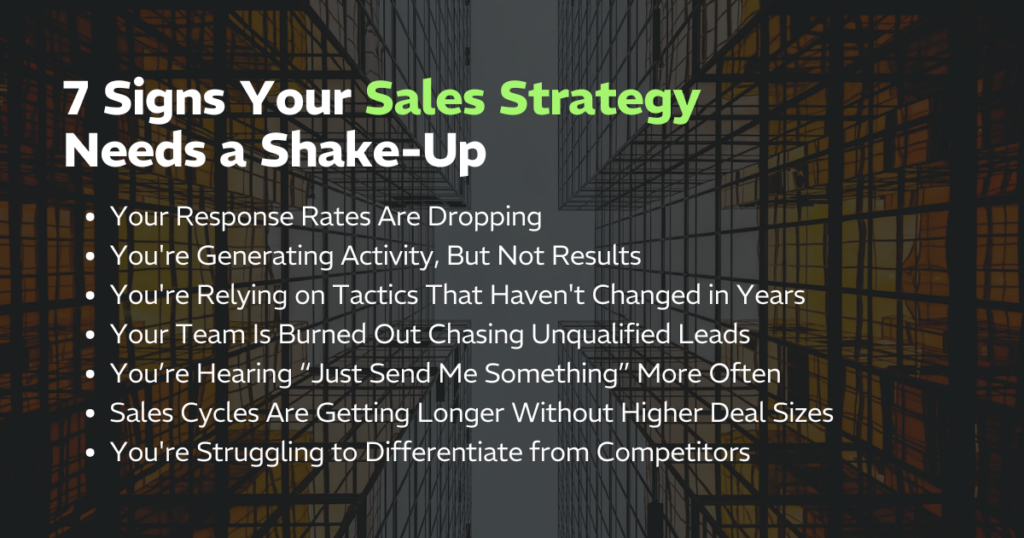Sales is evolving faster than ever, and traditional tactics are losing their edge. In today’s distracted digital landscape, earning buyer attention demands true sales innovation.
Top-performing sales professionals aren’t waiting for permission to innovate—they’re testing, learning, and evolving. It’s what separates the reps who are thriving from those who are falling behind.
In a world where buyers are doing more self-directed research and avoiding cold outreach altogether, innovation in sales isn’t optional. It’s the key to connection.
Why Sales Innovation Matters More Than Ever
Sales innovation means applying new ideas, tools, and strategies to better align with how modern buyers think, research, and engage. It’s about meeting customers where they are—and standing out from the noise.
It matters because buyers are overwhelmed. They’re bombarded with emails, messages, and mediocre sales pitches. They spend more time researching independently and engaging with content long before they respond to outreach.
The old playbook doesn’t cut it.
Innovative sales strategies improve the customer experience. They give you a competitive edge. They make your work more efficient and your message more resonant. It’s the difference between being ignored and being invited in.
For sales professionals looking to adapt, it’s not about throwing out your entire playbook—it’s about refining it with cutting-edge thinking that aligns with today’s buyers. Tools like AI are already reshaping the way teams connect and close, as more sales organizations embrace automation, real-time insights, and smarter qualification strategies. These shifts are at the heart of how AI is changing sales—and why innovation matters more than ever.
7 Signs Your Sales Strategy Needs a Shake-Up
Not sure if your current approach is holding you back? Here are seven key indicators that your sales strategy might be due for a reset:
Your Response Rates Are Dropping
Open rates, click-throughs, or replies are trending down. That’s a sign your messaging isn’t resonating with your target market.
You’re Generating Activity, But Not Results
The team is busy—lots of calls, emails, and meetings. But deals aren’t closing. High effort with low impact signals inefficiencies in your sales process or targeting.
You’re Relying on Tactics That Haven’t Changed in Years
Same pitch. Same email sequence. Same buyer personas. If your sales techniques haven’t evolved with your potential customers, it’s time for an upgrade.
Your Team Is Burned Out Chasing Unqualified Leads
Wasting energy on poor-fit prospects tanks morale. Innovation can help surface better-fit prospects and create a healthier, more productive environment—something we’ve seen firsthand when companies prioritize sales team performance rooted in people-first leadership.
You’re Hearing “Just Send Me Something” More Often
It sounds polite, but it’s often a brush-off. If your outreach isn’t compelling enough to earn real dialogue, your early value delivery isn’t solving real pain points.
Sales Cycles Are Getting Longer Without Higher Deal Sizes
Longer cycles with no payoff? That’s a red flag that your messaging or qualification process isn’t aligned with buyer urgency, budget, or business priorities.
You’re Struggling to Differentiate from Competitors
If your product or service feels like everyone else’s, sales innovation is how you build contrast. It’s how you define a smarter sales model that aligns with buyer expectations.
If any of these sound familiar, your strategy needs to evolve. The good news? Small, strategic changes can lead to high levels of improvement.

4 Sales Innovation Strategies to Stay Ahead
Innovation doesn’t mean blowing everything up. It means being willing to evolve. Here are four ways top-performing reps are doing just that to stay ahead of the curve.
Audit and Adapt Your Sales Process
Top reps are relentlessly reflective. After every call or meeting, they ask: What worked? What didn’t? How could this have gone better?
They reverse-engineer wins and losses. They spot patterns. They use data—from CRM systems, call recordings, and AI tools—to sharpen their instincts.
Self-awareness is the foundation of innovation.
Learn from Top Performers (Then Go One Better)
Sales isn’t a solo sport. The best reps are students of the game.
They pay attention to what high-performers are doing—inside and outside their organization. They study LinkedIn posts. Analyze competitor emails. Watch webinars. Take notes.
But they don’t just copy. They iterate. They test variations. They improve it. Emulation is a great starting point. Innovation is what happens next.
Embrace Digital Learning and Sales Intelligence
There’s no excuse not to know your potential buyers. Reps who embrace sales intelligence tools and digital learning have a real edge.
They listen to podcasts. Subscribe to newsletters. Follow thought leaders. They monitor competitor messaging and track industry trends.
They’re also active on social media, not just broadcasting—but learning, listening, and building credibility in digital spaces. These habits—staying curious, digitally connected, and customer-obsessed—are foundational to modern sales techniques that consistently outperform outdated tactics.
Experiment Relentlessly: Little Bets Lead to Big Breakthroughs
The most successful salespeople I know treat sales like a lab. They’re constantly experimenting—trying new openers, sending personalized videos, launching micro-newsletters. They test, measure, and refine. When something works, they double down. When it doesn’t, they pivot. Innovation lives in that 10% of your effort dedicated to learning and iteration—the space where curiosity beats comfort.
In a world changing this fast, standing still is the real risk. What gets scheduled gets done—so carve out time each week to try something new. Track the results. Reflect on the outcome. And above all, keep evolving. Because the most important investment you can make in your sales success is the one you make in yourself.

Sales Innovation Examples That Broke the Mold
Sales innovation doesn’t always mean launching a new tool or chasing the latest trend. Sometimes, it’s about a bold shift in mindset—how you show up, how you connect, how you lead. The best examples? They span industries but share a common thread: a relentless focus on creating unforgettable buyer experiences. Here are a few standout stories that prove just how powerful that shift can be.
Savannah Bananas: Selling the Show, Not Just the Seats
Instead of competing with every other minor league team on ticket prices or giveaways, the Savannah Bananas rewrote the entire game-day experience. Led by Jesse Cole, they made baseball fun again—with dancing players, no hidden fees, and a wildly viral fan-first approach. The result? They stopped selling seats and started selling spectacle.
CBH Homes: Creating a Culture That Sells
Idaho-based CBH Homes isn’t just a high-performing builder—they’re a brand built on love, leadership, and contagious energy. Under Ronda Conger’s leadership, they’ve proven that culture isn’t a buzzword—it’s a growth engine. Their team shows up differently, sells with joy, and connects with buyers in a way that feels human and real.
McKibbon Hospitality: Rebuilding Trust Through Empathy
As the hospitality industry faced its most uncertain moment, McKibbon Hospitality leaned into empathy. Rather than default to discounts or volume, they led with human connection—personalized outreach, clear communication, and guest-first strategy. It wasn’t just a recovery play; it was a redefinition of how sales and service intertwine.
How to Build a Sales Culture That Champions Innovation
Sales innovation doesn’t happen by accident. It happens when leadership creates space for it.
That means:
- Giving reps permission to test and fail
- Building “10% innovation sprints” into the quarter
- Sharing and celebrating what works
- Turning experimentation into process
A culture of innovation starts at the top. When sales leaders empower teams to think creatively, and managers know how to develop trust and accountability, experimentation becomes a shared expectation—not a risky move.
When your business model depends on growth, building an agile, learning-oriented sales team is your competitive advantage.
Is Your Sales Innovation Evolving as Fast as Your Customer?
Your customers are changing—fast. Their expectations are higher. Their attention is shorter. Their tolerance for mediocre sales approaches is gone.
So the question is: Are you evolving, too?
The most successful salespeople I meet aren’t afraid to challenge the norm. They’re energized by the unknown. They experiment. And they win.
Want to future-proof your sales team and drive long-term impact? Let’s talk about how sales innovation transforms performance in today’s market. Explore what’s possible in the Sell for Impact keynote.



![[RYAN] Featured Image - Effective Pre-Call Planning for Sales Success [RYAN] Featured Image - Effective Pre-Call Planning for Sales Success](https://ryanestis.com/wp-content/uploads/bb-plugin/cache/RYAN-Featured-Image-Effective-Pre-Call-Planning-for-Sales-Success-1024x683-panorama-5450085f2a20c8468e6be608dffdca5c-.jpg)
![[RYAN] Featured Image - Effective Sales Training Image of Mountain in the background](https://ryanestis.com/wp-content/uploads/bb-plugin/cache/RYAN-Featured-Image-Effective-Sales-Training-1024x538-panorama-675783a5b1248eec528a45c7f36d5e73-.png)




![[RYAN] Featured - From Pitch to Partner_ Sales Techniques That Build Long-Term Wins [RYAN] Featured - From Pitch to Partner_ Sales Techniques That Build Long-Term Wins](https://ryanestis.com/wp-content/uploads/bb-plugin/cache/RYAN-Featured-From-Pitch-to-Partner_-Sales-Techniques-That-Build-Long-Term-Wins-1024x681-panorama-8f1fd7852348ffecffeb98278e20480d-.jpg)
